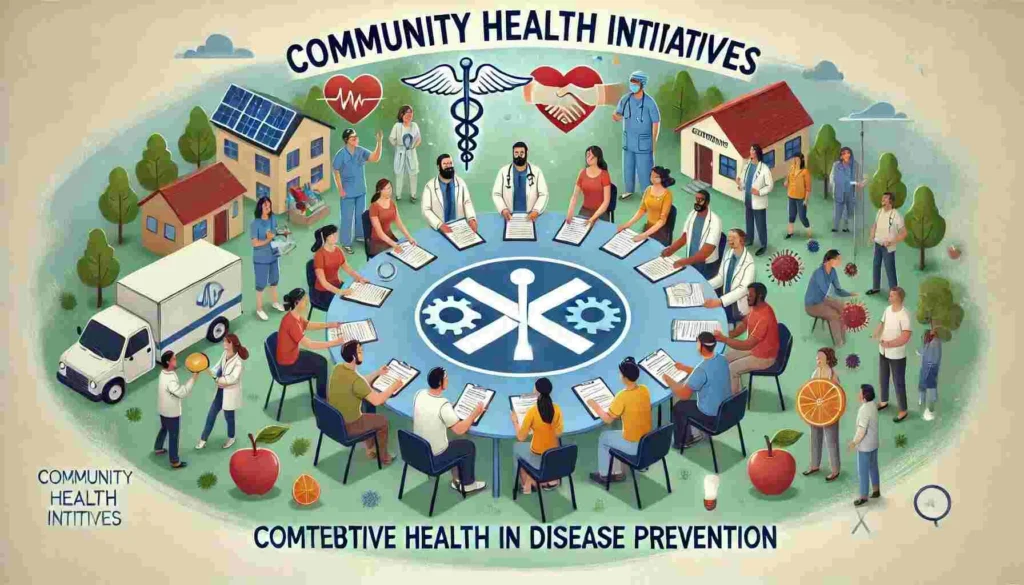
Community Health Initiatives: Collective Efforts in Disease Prevention
Introduction: The Power of Community Health
Community health initiatives are a cornerstone in the fight against preventable diseases. These efforts involve collaborative actions by individuals, organizations, and governments to create healthier environments and reduce health disparities. By addressing the root causes of diseases, community-driven health programs have the power to create long-lasting impacts on public well-being. This blog delves into the importance, strategies, and success stories of community health initiatives aimed at disease prevention.
Part 1: Understanding Community Health Initiatives
What Are Community Health Initiatives?
Community health initiatives are organized efforts focused on improving the overall health and well-being of a specific population. These programs often tackle issues such as chronic disease prevention, infectious disease control, mental health awareness, and promoting healthy lifestyles. They leverage local resources and knowledge to address health challenges unique to a community.
Why Are Community Efforts Essential in Disease Prevention?
- Addressing Local Health Challenges: Each community faces unique health issues influenced by its socio-economic, environmental, and cultural factors. Community-based programs allow for tailored solutions.
- Promoting Health Equity: Health disparities are a global challenge. Grassroots initiatives aim to bridge the gap by providing equal access to health education, screenings, and preventive care.
- Cost-Effective Solutions: Preventive measures, such as vaccinations and health awareness campaigns, reduce the financial burden of treating advanced diseases.
- Empowering Individuals: Education and active participation in health programs foster a sense of responsibility and empowerment among community members.
Key Elements of Effective Community Health Programs
- Stakeholder Collaboration: Successful initiatives involve partnerships between local governments, healthcare providers, schools, and non-profits.
- Data-Driven Strategies: Using local health data to identify problems and measure outcomes ensures programs are effective.
- Cultural Relevance: Tailoring messages and interventions to fit the community’s cultural context enhances participation and impact.
Real-World Examples of Community Health Success
Immunization Drives
Immunization campaigns have proven to be one of the most impactful community health initiatives. For example, polio eradication efforts in developing countries showcase how widespread vaccination can control, and even eliminate, infectious diseases.
- Community Engagement: Local leaders often advocate for vaccinations, building trust and encouraging participation.
- Mobile Clinics: Reaching remote areas ensures that marginalized populations are not left out.
Promoting Healthy Lifestyles
Lifestyle diseases, such as diabetes and hypertension, are on the rise globally. Community programs often focus on promoting physical activity, healthy eating, and smoking cessation.
- Group Exercise Programs: Free fitness classes in public parks encourage residents to stay active.
- Healthy Eating Workshops: Teaching families how to prepare nutritious meals helps combat obesity and related diseases.
Mental Health Awareness Campaigns
Breaking the stigma around mental health is another vital aspect of community initiatives. Programs often focus on educating people about signs of mental illness and encouraging early intervention.
- School Programs: Mental health education for students helps identify and address issues early.
- Community Support Groups: Providing a safe space for individuals to share experiences fosters resilience and recovery.
Strategies for Launching Community Health Initiatives
Assessing Community Needs
Every initiative begins with understanding the community’s specific health challenges. This involves:
- Conducting surveys and focus groups.
- Reviewing local health data and trends.
- Engaging community leaders and members for insights.
Building Strong Partnerships
Collaboration amplifies the reach and effectiveness of health programs. Partner with:
- Local businesses for funding and resources.
- Healthcare providers for medical expertise.
- Schools and universities for educational outreach.
Implementing Sustainable Programs
Sustainability ensures long-term benefits. Strategies include:
- Training local volunteers to continue efforts.
- Securing recurring funding through grants and donations.
- Periodically evaluating and adapting programs based on feedback and outcomes.
Leveraging Technology for Community Health
One of the most effective ways to expand the reach and impact of community health initiatives is through technology. Digital tools can break down barriers, streamline communication, and improve access to vital resources. Here’s how technology is reshaping community health efforts:
- Telemedicine Services: Telemedicine has revolutionized how communities access healthcare, especially in rural areas. By providing virtual consultations, individuals can receive timely medical advice without traveling long distances.
- Mobile Health Apps: Apps focusing on health tracking, reminders for medication, or exercise routines encourage individuals to take control of their health.
- Social Media Campaigns: Platforms like Facebook, Instagram, and Twitter are powerful tools for spreading health awareness, organizing events, and mobilizing volunteers.
Empowering Communities with Health Education
Education is at the core of disease prevention. Empowering people with the knowledge to make informed health decisions can significantly reduce the prevalence of preventable diseases.
- Workshops and Seminars: Hosting community workshops on topics such as nutrition, physical activity, and managing stress equips participants with actionable insights.
- Culturally Tailored Education: Language barriers and cultural differences can hinder understanding. By creating materials that reflect the community’s culture and values, initiatives can ensure inclusivity and effectiveness.
- Interactive Learning: Innovative methods like role-playing, simulations, and storytelling make health education more engaging and memorable.
Engaging Youth in Health Initiatives
The involvement of young people in community health initiatives ensures sustainability and innovation. Youth bring energy, fresh perspectives, and a natural inclination towards technology, making them valuable contributors to health campaigns.
- School-Based Programs: Collaborating with schools to introduce health education into the curriculum can lay the foundation for lifelong healthy habits.
- Youth Leadership Opportunities: Training young people as health ambassadors empowers them to spread awareness among their peers and families.
- Social Media Challenges: Engaging youth through creative challenges and campaigns on social platforms can amplify messages about healthy living.
Overcoming Challenges in Community Health Initiatives
Implementing community health programs comes with its share of challenges. By identifying potential roadblocks early, organizers can develop strategies to overcome them.
- Limited Funding: Financial constraints often restrict the scope of initiatives. Crowdfunding, public-private partnerships, and grants from health organizations can bridge the gap.
- Resistance to Change: Behavioral change is often met with resistance. Building trust through consistent communication and showcasing success stories can help overcome skepticism.
- Lack of Awareness: Some communities may not recognize the importance of preventive measures. Continuous education and outreach can shift perceptions.
Measuring the Impact of Health Initiatives
Assessing the effectiveness of community health initiatives is crucial for understanding their success and identifying areas for improvement.
- Collecting Data: Use surveys, interviews, and health screenings to gather information about the program’s reach and impact.
- Tracking Health Outcomes: Monitoring indicators such as vaccination rates, reduced hospital visits, and improved chronic disease management provides measurable proof of success.
- Community Feedback: Engaging participants for their opinions ensures that programs are aligned with their needs and expectations.
Collaboration Across Sectors
Community health initiatives thrive on the principle of collaboration. Bringing together diverse stakeholders creates a strong network that can address complex health issues effectively.
- Government Agencies: Public health departments can provide funding, infrastructure, and policy support to health programs.
- Non-Governmental Organizations (NGOs): NGOs often have expertise in mobilizing resources and executing large-scale health campaigns.
- Local Businesses: Companies can contribute through sponsorships, in-kind donations, or by promoting health among their employees and customers.
Encouraging Preventive Health Screenings
Screenings for diseases like diabetes, hypertension, and cancer play a crucial role in early detection and prevention. Community health programs should actively promote these services.
- Health Fairs: Organizing free health fairs that offer screenings, vaccinations, and health consultations makes preventive care more accessible.
- Mobile Clinics: Bringing health services directly to underserved areas ensures no one is left behind.
- Awareness Campaigns: Educating communities about the importance of regular check-ups can encourage proactive health management.
Building Resilient Communities
Resilience is the ability of a community to adapt and thrive in the face of challenges. Community health initiatives can strengthen resilience by fostering a supportive and health-conscious environment.
- Peer Support Networks: Encouraging community members to support one another during health challenges builds a sense of solidarity.
- Skill-Building Programs: Training individuals in first aid, caregiving, or nutritional planning equips them to handle emergencies and chronic conditions.
- Disaster Preparedness Plans: Teaching communities how to respond to health crises, such as natural disasters or pandemics, reduces the long-term impact on public health.
Success Stories: The Impact of Community Health Initiatives
Around the globe, numerous community health initiatives have proven that collective efforts can lead to remarkable outcomes. By drawing inspiration from these success stories, other communities can replicate these models to achieve similar results.
- Eradicating Malaria in Zanzibar
Zanzibar’s community-driven efforts to combat malaria involved distributing insecticide-treated bed nets, educating residents about prevention, and organizing regular spraying campaigns. These measures reduced malaria prevalence dramatically, showcasing the power of targeted interventions. - Blue Zones Project
Communities in areas known as “Blue Zones,” such as Okinawa, Japan, and Loma Linda, California, have implemented lifestyle-focused initiatives to promote long and healthy lives. Programs that emphasize plant-based diets, physical activity, and social connections have yielded lower rates of chronic diseases and higher life expectancies. - Mental Health Awareness in India
In India, grassroots organizations have introduced community mental health programs in rural areas, where access to professional services is limited. Through workshops and telemedicine, these initiatives have successfully reduced stigma and improved mental health literacy.
Scaling Community Health Initiatives
Expanding the scope of health initiatives ensures that a larger population can benefit. Here are some strategies to scale impactful programs:
- Securing Long-Term Funding
Financial stability is key to sustaining and expanding health programs. Communities can explore partnerships with national and international organizations, apply for grants, or leverage local businesses for sponsorships. - Training Local Leaders
Empowering community members to take leadership roles ensures that initiatives remain community-driven. Training programs can focus on health advocacy, management skills, and volunteer coordination. - Expanding Geographical Reach
Successful programs in one area can serve as models for other communities. Sharing best practices, tools, and training materials can help replicate success on a larger scale.
The Role of Policy in Supporting Community Health
Supportive policies are critical to the success of community health initiatives. Governments can enhance these efforts by:
- Allocating Budgets for Public Health
Dedicated funding for preventive care, awareness campaigns, and health education strengthens the foundation of community health programs. - Enacting Health Regulations
Policies such as smoking bans in public areas, restrictions on junk food advertising, and incentives for physical activity can drive healthier behaviors. - Integrating Health Services
Streamlining access to preventive services by connecting them with primary healthcare ensures wider reach and impact.
Building a Culture of Health
Creating a health-conscious culture within a community is essential for sustained disease prevention. This involves reshaping mindsets and fostering a collective sense of responsibility for well-being.
- Celebrating Health Milestones
Communities can organize events to recognize and celebrate health achievements, such as reduced smoking rates or increased participation in fitness programs. - Making Health a Daily Priority
Encouraging small daily actions, like walking to work or incorporating more vegetables into meals, creates lasting change over time. - Promoting Intergenerational Learning
Sharing health knowledge across generations ensures that children and seniors alike benefit from collective wisdom and support.
Community Empowerment Through Inclusion
For health initiatives to be truly impactful, they must embrace inclusivity and diversity. Marginalized groups often face unique health challenges that require tailored approaches.
- Addressing Gender-Specific Health Needs
Women and men may require different preventive measures, such as breast cancer screenings for women or prostate health education for men. Inclusive programs address these differences while fostering equality. - Engaging Ethnic Minorities
Programs that consider cultural traditions, languages, and dietary habits resonate better with diverse populations, encouraging higher participation rates. - Supporting Individuals with Disabilities
Accessible health services, information, and infrastructure ensure that individuals with disabilities are not left out of community health efforts.
Embracing Innovation in Disease Prevention
Innovation drives progress in disease prevention. Incorporating creative solutions ensures that community health programs remain effective and adaptive to emerging challenges.
- Wearable Technology
Devices like fitness trackers and smartwatches enable individuals to monitor their physical activity, heart rates, and sleep patterns, encouraging proactive health management. - Artificial Intelligence (AI)
AI-powered tools can analyze health data to identify trends, predict outbreaks, and optimize resource allocation in community programs. - Gamification
Turning health initiatives into engaging games—such as step challenges or reward-based health goals—encourages participation and fosters healthy competition.
Creating Partnerships for a Healthier Future
Collaboration lies at the heart of community health initiatives. By forging strong partnerships, communities can pool resources, knowledge, and expertise to tackle health challenges collectively.
- Global Alliances
International organizations like the World Health Organization (WHO) provide technical guidance, funding, and frameworks for health programs. - Corporate Social Responsibility (CSR)
Local businesses can contribute by sponsoring health events, donating resources, or organizing employee wellness programs that extend to the broader community. - Academic Institutions
Universities and research centers play a critical role in evaluating the effectiveness of health programs, developing innovative solutions, and training future health professionals.
The Future of Community Health
As the world becomes increasingly interconnected, the future of community health initiatives lies in global collaboration and leveraging advancements in science and technology. Key trends include:
- Personalized Health Solutions
Using genetic data and individual health histories to design personalized preventive strategies. - Sustainable Practices
Incorporating environmentally friendly practices into health programs to address the intersection of climate change and public health. - Enhanced Data Sharing
Global health data sharing can improve disease surveillance, outbreak response, and resource allocation.



